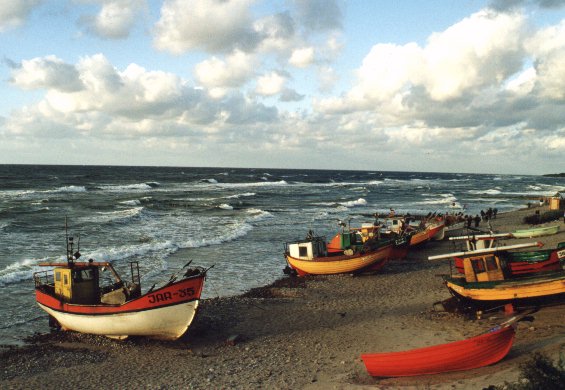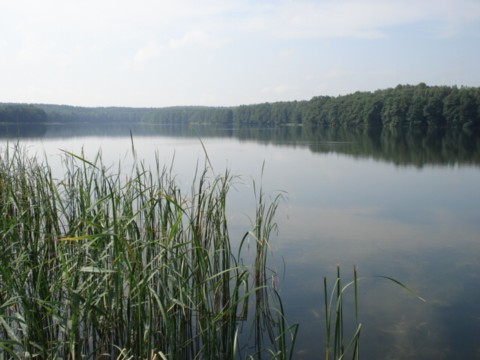West Pomerania
County: Zachodniopomorskie

The beach at Jarosławiec
Introduction
Poland’s northern border is primarily a border with the sea, namely the 524 km long coastline along the Baltic Sea.
In the coastal areas there is a favorable microclimate, characterized by many hours of sunshine and the considerable humidity in the air, which also has a healing content of iodine. Extensive forest areas and the absence of major industrial companies ensure a clean air in the area. Favorable ocean currents still bring new building material to the long sandy beaches.
From the coast and 200 km inland you will find a varied landscape, consisting of lakes, created after the ice age, rivers, forests and hills.
The land area of Poland, located on the Baltic Sea coast – on the stretch from the western border of Poland on the Odra River and to the border with Russia – is called Pomerania, in Polish: Pomorze, which means the land by the sea. Pomorzanie was the name of the largest of the Slavic tribes that originally populated this area.
Historically, the designation of Pomerania encompassed the land that lay along the Baltic coast from Rostock to Gdańsk. east of Gdańsk and the river Wisła lay Prusy, inhabited by a Baltic speaking people. It is said that the southern border of earliest Pomerania passed along the rivers Notec and Warta, but for most of the Middle Ages and later the boundaries of Pomorze Szczecińskie (western Pomerania) and Pomorze Gdańskie (eastern Pomerania) were somewhat further north.
Today, Pomerania is divided into West Pomerania with Szczecin as the main city and East Pomerania with Gdańsk as the main city.

Forest lake at Krąg
The history of the area
Danish-Polish relations:
Erik of Pomerania
Accommodation
Also read about accommodation under individual cities in the region.
Cities in West Pomerania
Almost all Pomeranian cities have a very ancient history. The oldest of them are of Slavic origin. Some have arisen in connection with princely castles, fortresses belonging to the Crusaders, chivalry castles, royal castles or monasteries. Among them we find fishing villages as well as market towns and among the youngest coastal towns that have arisen as a result of an increasing interest in the healing qualities of water and air.
Also follow the links below for a brief description of the individual cities and towns:
West Pomeranian County:
Barlinek . -Białogard . -Chojna -Choszczno. -Darłowo -Drawsko Pomorskie. -Dziwnów -Dziwnów -Dźwirzyno . -Goleniów . -Gryfice -Gryfino . -Jarosławiec -Kamień Pomorski -Kołbacz -Kołobrzeg -Koszalin . -Dziwnów . -Międzyzdroje -Dziwnów -Mielno -Moryń -Mrzeżyno -Myślibórz. -Niechorze . -Pogorzelica -Połczyn Zdrój . -Police . -Pyrzyce. -Sarbinowo -Sławno. -Stargard Szczeciński . -Świdwin . -Świnoujście -Szczecin -Szczecinek . -Trzebiatów . -Ustronie Morskie . -Wałcz . -Wolin
Smaller sites:
Bielin: Village 84 km south of Szczecin – Cieszyno Drawskie: Village 8 km north of Zlocieniec and 122 km east of Szczecin. – Power: Village (50 km east of Koszalin ) with impressive chivalry. The castle, which lies beautifully down to a lake, was built in the early 14th century by the genus Podewils, in the 16th-17th century. expanded in Renaissance style. Remodeled in the 19th century. The building burned in 1945. Rebuilt after World War II. From the original castle facility is preserved chapel and cellar with sliding shed. Today, the building is utilized as a hotel. – Piaski Wielkie: Village 7 km east of the town of Wolin and 35 km east of Swinoujscie.
Each site has links to descriptions of guest houses, hotels and other places to stay and dine.
Translated into English by Google Translate. Spangshus.dk accept no liability for any errors or omissions in translation.
Town
Map

Search
Most used tags
churches (205) Castles (86) Monasteries (79) Town walls (74) Lakes (71) Town halls (67) Rivers (65) Castles1 (62) Mansions (55) Museums (51) Regional museums (38) Town gates (36) Abbey churches (35) Castle ruins (30) Cathedrals (26) Forests (25) Health resorts (24) Mounds (23) Water sports (23) National parks (22)Click for all tags
Denne side er også tilgængelig på dansk. This page and contents is (c) Copyright 2018- www.spangshus.dk. Based on Inviator software by ISCA Software